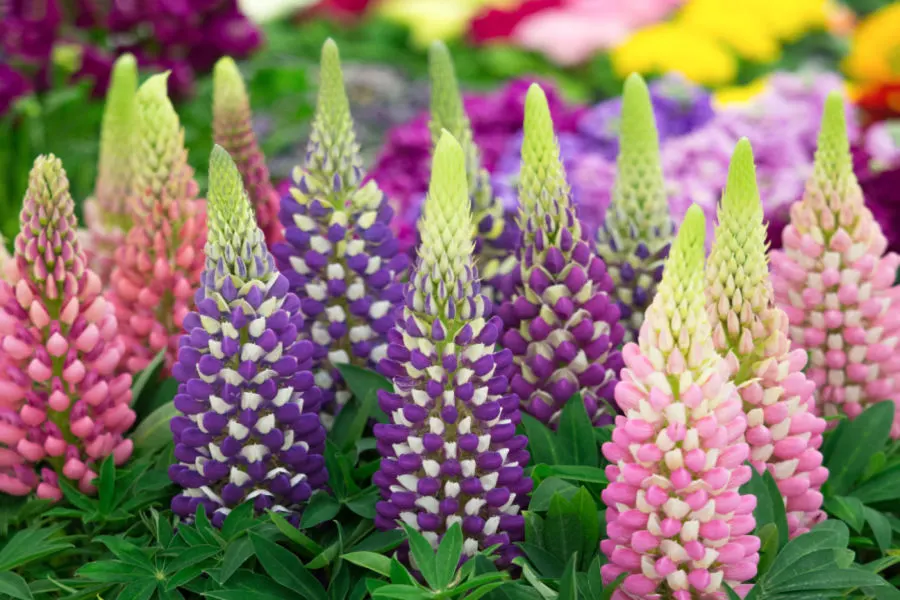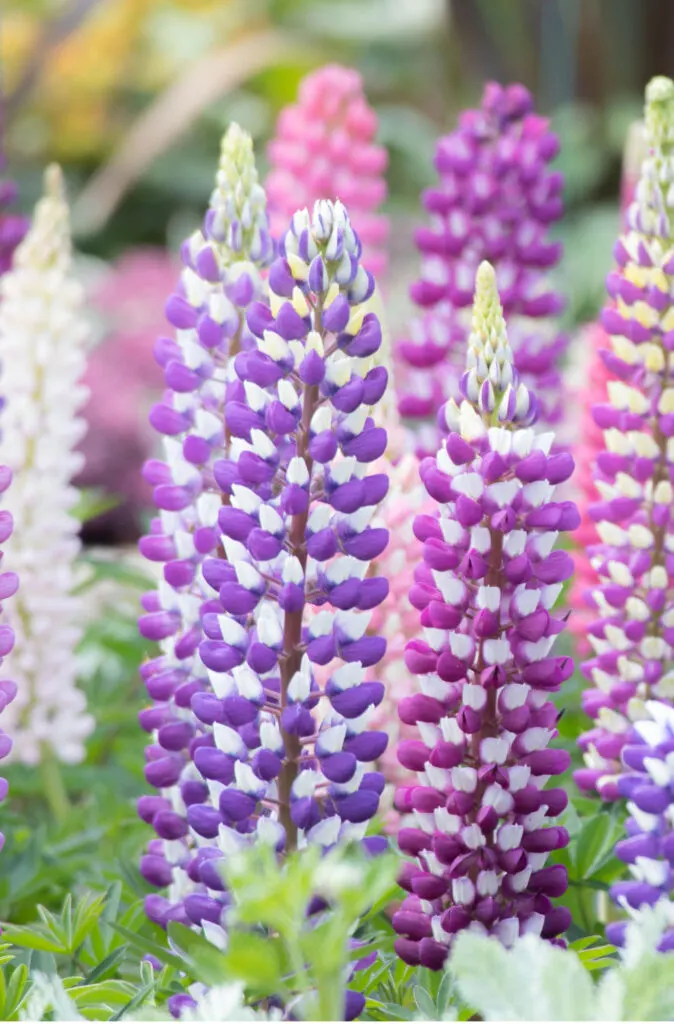Why should you plant lupines in your flowerbeds this year? Because this incredible perennial can add stunning beauty to your landscape – and help your other plants grow better in the process!
Lupines might be the most underrated perennial of all, especially when you realize just how much this beautiful, easy care, long-blooming plant can bring to your landscape.
Talk about a well kept secret! Of all the perennial favorites that gardener’s plant in their flowerbeds each year, lupines rarely get a mention. In fact, many have never even heard of the herbaceous plant that not only grows in poor soil, but can actually improve it while it does!
So what exactly are lupines? And why are they such an amazing perennial to plant and grow? For starters, not only does the perennial have some of the prettiest and most unusual blooms around, it also happens to showcase those flowers for a lengthy amount of time.

Just like hostas, daylilies, coneflowers and many of the other commonly planted perennial flowers, lupines come back each year to provide color and interest. But, as you will see below, unlike those other perennials, they bring quite a few additional advantages to you and the flowerbeds you plant them in.
With that in mind, here is a look at how to grow lupines, and why they can be such a wondrous addition to your landscape!
Why To Plant Lupines
Lupines are actually a member of the peanut and soybean (legume) family. Although they prefer a more sandy soil, they can establish well in nearly all types of soil – whether it be sandy, loamy or even more clay-based soils.
But here is the good news, wherever they grow, they actually improve the soil. And in two distinct ways. First, lupines send down a long taproot into the soil. That taproot is excellent for breaking up hard soil and creating air channels. Channels that can help loosen the soil over time.
In addition to helping to create better soil structure, lupines, just like other legumes, help to fix nitrogen levels in the soil as they grow. It’s really a win-win for the other perennials that grow nearby. Not only can they have access to more nutrients, but the soil becomes easier to grow in as well!

If all of that wasn’t enough, lupines also happen to be deer-resistant. As such, planting them with or close by other perennials deer love can often help protect those plants. Lupines also are rarely if ever bothered by pests, nor do they attract other pests to other perennials nearby
Finally, lupines also happen to be highly drought tolerant as well. In fact, once lupines establish in the soil, they will never need to be watered again. Just one more reason they are truly a low maintenance perennial wonder!
How To Plant Lupines
Lupines, unlike many other perennial flowers, grow better from seed than from direct transplant. This actually is a wonderful cost saving benefit of planting in your flowerbeds. One thing is for sure, it sure beats having to purchase expensive transplants.
Seeds can be sown in late fall or early spring. Spring is really the better time for planting as long as you get the seeds in the soil while it is still cool. Planting in the fall can often put seeds at risk from birds and other animals looking for a quick meal in the winter.

The outer skin of a lupine seed is extremely tough. Because of this, it is best to soak them for twelve to twenty-four hours prior to planting to soften the seed. Not only does it help with germination, it helps provide the seed a bit of early moisture too.
You can sow lupine seed four to five weeks before your last frost date. You can still sow after this time frame, but it is better to sow while the soil is still cool. Not only will the seeds germinate better, but they will also bloom earlier in the growing season as well.
One note to mention on lupines is they can be toxic to dogs, cats, and even humans if consumed – please keep this in mind as part of your planting plan.
Planting With Ease…
To plant, simply loosen the earth a few inches down and then scatter seeds every few inches on top of the soil. Loosening the soil a bit will help the long taproot get off to a good growing start. Next, push down with the seed ever so slightly with your finger in the soil about 1/8th of an inch deep to help set it for germination.
Once seeds germinate, thin plants to six to twelve inches apart depending on the variety. Apply mulch to the space after the seedlings reach a few inches in height. This helps to conserve moisture and keep competing weeds out.
Lupine Varieties – How To Plant Lupines
There are all kinds of lupine varieties to grow – from dwarf varieties to taller spiked lupines that ooze with big color. Here are 3 of our favorites to add big color and interest:
- Russell Lupine Seeds : Perhaps the most commonly known and grown variety of lupines in the Russell variety. Not only do they grow tall, their large, thick spikes overflow with bright, vivid colors. They can really light up a landscape for sure! The Russell lupine is also often refereed to as a Garden Lupine Russell Lupine Seeds Affiliate Seed Link
- Lupine Seeds (Dwarf) – Pixie : The Pixie variety is the perfect choice for growing lupines in small spaces. It can handle both full sun and partial shade and still bloom quite strong. Seed Link : Lupine Seeds (Dwarf) – Pixie
- Lupine Seeds – Hartwegii Pastel Mix : The Hartwegii variety produces pastel-colored bonnets on top of extremely compact plants. All lupines are wonderful for attracting bees, butterflies and other pollinators, and the Hartwegii is no exception. Affiliate Seed Link : Lupine Seeds Hartwegii Pastel Mix

End Of Season Care – How To Plant & Maintain Lupines
Lupines are quite easy to get to bloom a second time in early to mid fall. Especially if you happen to live in a cooler climate with an early Autumn season. Once the initial set of blooms dies off, deadhead the plants to encourage a second bloom in early fall.
Once late fall arrives, lupines will begin to brown off and die back. At this point, you can simply cut the plants flush to the ground and mulch. A few inches of mulch over the plants will help to protect the plants through winter.
Most lupines will grow well in growing zones 4 through 9, although they can struggle to bloom more in warmer climates with hot, humid summer. Lupines plants will usually die off after a few years, but are such good self seeders that new plants are constantly coming on to replace those dying off.
Here is to planting lupines in your flowerbeds this year, and help your beds grow healthier and more colorful in the process! Happy Gardening – Jim and Mary
Jim and Mary Competti have been writing gardening, DIY and recipe articles and books for over 15 years from their 46 acre Ohio farm. The two are frequent speakers on all things gardening and love to travel in their spare time.
As always, feel free to email us at thefarm@owgarden.com with comments, questions, or to simply say hello! You can sign up for our free email list in the subscribe now box in the middle of this article. Follow us on Facebook here : OWG Facebook. This article may contain affiliate links.
